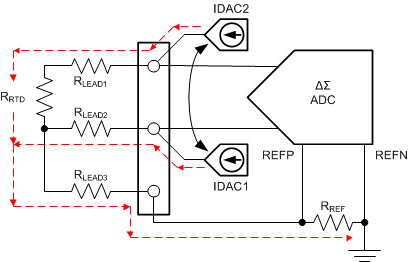SBAA275A June 2018 – March 2023 ADS1120 , ADS112C04 , ADS112U04 , ADS1147 , ADS1148 , ADS114S06 , ADS114S06B , ADS114S08 , ADS114S08B , ADS1220 , ADS122C04 , ADS122U04 , ADS1247 , ADS1248 , ADS124S06 , ADS124S08 , ADS125H02 , ADS1260 , ADS1261 , ADS1262 , ADS1263
- A Basic Guide to RTD Measurements
- 1RTD Overview
-
2RTD Measurement Circuits
- 2.1 Two-Wire RTD Measurement With Low-Side Reference
- 2.2 Two-Wire RTD Measurement With High-Side Reference
- 2.3 Three-Wire RTD Measurement, Low-Side Reference
- 2.4 Three-Wire RTD Measurement, Low-Side Reference, One IDAC Current Source
- 2.5 Three-Wire RTD Measurement, High-Side Reference
- 2.6 Four-Wire RTD Measurement, Low-Side Reference
- 2.7 Two Series Two-Wire RTD Measurements, Low-Side Reference
- 2.8 Two Series Four-Wire RTD Measurements
- 2.9 Multiple Two-Wire RTD Measurements
- 2.10 Multiple Three-Wire RTD Measurements
- 2.11 Multiple Four-Wire RTD Measurements in Parallel
- 2.12 Universal RTD Measurement Interface With Low-Side Reference
- 2.13 Universal RTD Measurement Interface With High-Side Reference
- 3Summary
- 4Revision History
1.4.2 IDAC Current Chopping
As described in the previous section, the two current sources must be matched to cancel the lead resistances of the RTD wires. Any mismatch in the two current sources may be minimized by using the multiplexer (MUX) to swap or chop the two current sources between the two inputs. Taking two measurements in each configuration and averaging the results reduces the effects of mismatched current sources.
Using the configuration from Figure 1-5, Equation 6 results in the first measurement. Figure 1-6 swaps IDAC1 and IDAC2, and Equation 9 results in the second measurement.
 Figure 1-6 Swapping IDAC1 and IDAC2 to Chop the Measurement
Figure 1-6 Swapping IDAC1 and IDAC2 to Chop the MeasurementTo chop the RTD measurement, we average the first and second measurements. Take Equation 6, add it to Equation 9 and then divide by two to average the result. This is shown in the following:
Then combine (IIDAC1 + IIDAC2) terms:
Then cancel the IIDAC1 + IIDAC2 terms and set RLEAD1 = RLEAD2 = RLEAD to get the following equations:
After this, the RLEAD terms are cancelled as well.
Going through the results to Equation 13, it is not important that IIDAC1 and IIDAC2 are not equal, it is only important that IIDAC1 and IIDAC2 are the same values after they are swapped. If they are the same, then the (IIDAC1 + IIDAC2) terms cancel out.
There may still be errors in the system. Here, RLEAD1 and RLEAD2 are assumed to be the same. If they are different, this becomes an error. Also, if there are leakage currents in the measurement (from TVS or other protection diodes for example), then the leakage contributes to the error.